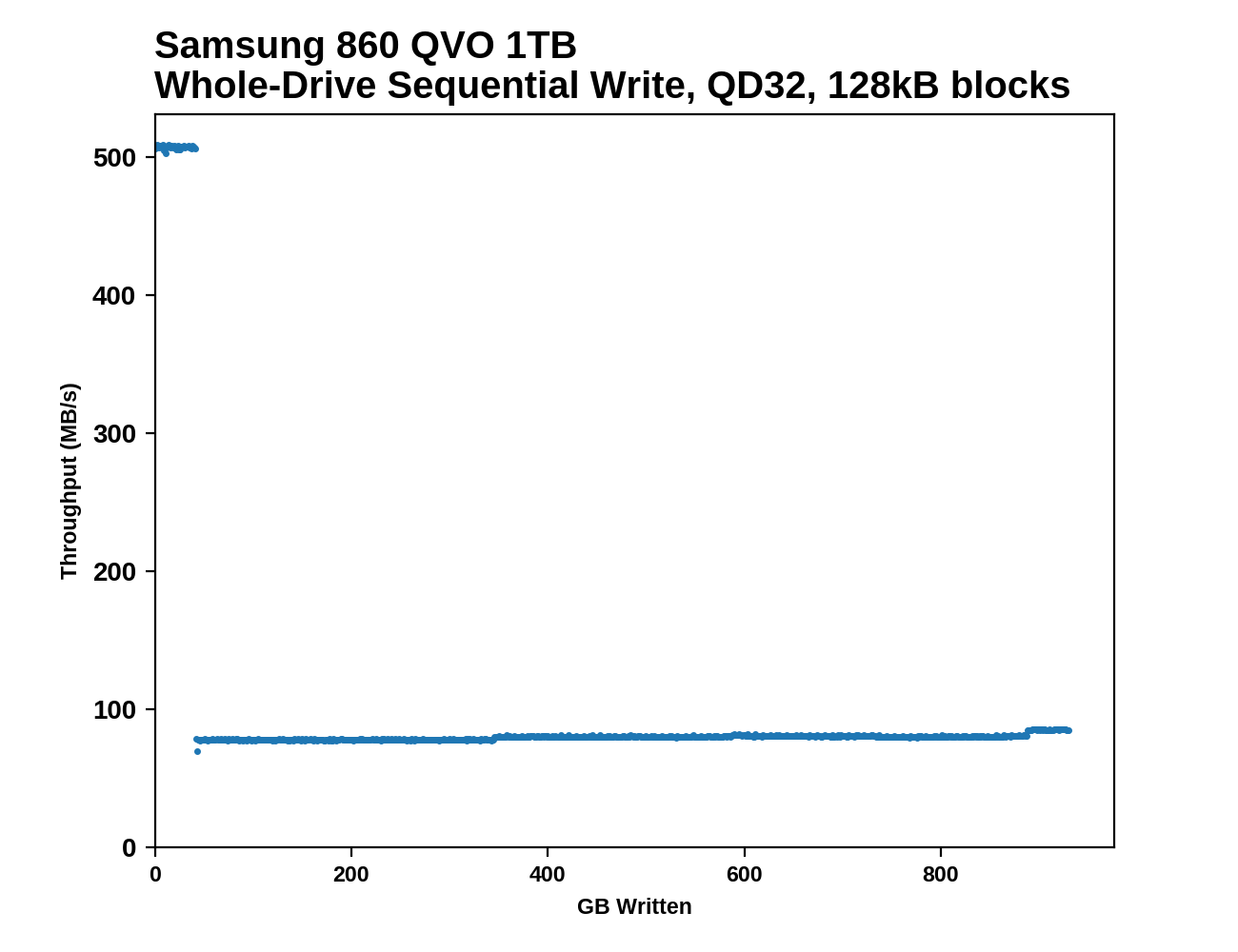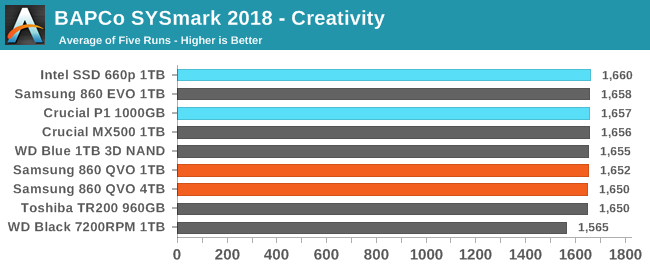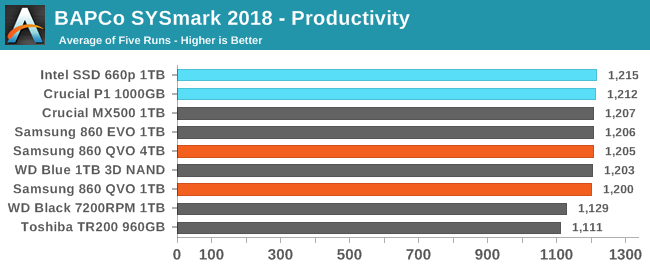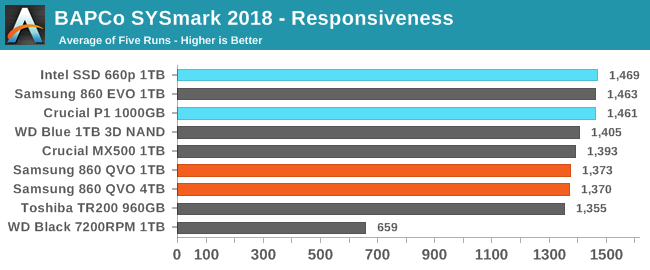The Samsung 860 QVO (1TB, 4TB) SSD Review: First Consumer SATA QLC
by Billy Tallis on November 27, 2018 11:20 AM ESTWhole-Drive Fill: Testing SLC Cache Size
This test starts with a freshly-erased drive and fills it with 128kB sequential writes at queue depth 32, recording the write speed for each 1GB segment. This test is not representative of any ordinary client/consumer usage pattern, but it does allow us to observe transitions in the drive's behavior as it fills up. This can allow us to estimate the size of any SLC write cache, and get a sense for how much performance remains on the rare occasions where real-world usage keeps writing data after filling the cache. Samsung's official specifications are:
| Samsung 860 QVO Secondary Specifications | |||||
| Capacity | 1 TB | 2 TB | 4 TB | ||
| SLC Cache Size |
Min | 6 GB | 6 GB | 6 GB | |
| Max | 42 GB | 78 GB | 78 GB | ||
| Sequential Write |
SLC Cache | 520 MB/s | |||
| QLC | 80 MB/s | 160 MB/s | 160 MB/s | ||
Our results show the following:
 |
|||||||||
The Samsung 860 QVOs run out of SLC cache right on schedule, at 42 GB for the 1TB model and 78 GB for the 4TB. After that, they are both slow and very steady for the rest of the test.
 |
|||||||||
| Average Throughput for last 16 GB | Overall Average Throughput | ||||||||
The 1TB 860 QVO falls below the sequential write speed of a 1TB hard drive once the SLC cache runs out, but the 4TB model is able to sustain twice the write speed and remains ahead of not just the hard drive's speed, but also some of the slower TLC drives.
BAPCo SYSmark 2018
BAPCo's SYSmark 2018 is an application-based benchmark that uses real-world applications to replay usage patterns of business users, with subscores for productivity, creativity and responsiveness. Scores represnt overall system performance and are calibrated against a reference system that is defined to score 1000 in each of the scenarios. A score of, say, 2000, would imply that the system under test is twice as fast as the reference system.
SYSmark scores are based on total application response time as seen by the user, including not only storage latency but time spent by the processor. This means there's a limit to how much a storage improvement could possibly increase scores, because the SSD is only in use for a small fraction of the total test duration. This is a significant difference from our ATSB tests where only the storage portion of the workload is replicated and disk idle times are cut short to a maximum of 25ms.
| AnandTech SYSmark SSD Testbed | |
| CPU | Intel Core i5-7400 |
| Motherboard | ASUS PRIME Z270-A |
| Chipset | Intel Z270 |
| Memory | 2x 8GB Corsair Vengeance DDR4-2400 CL17 |
| Case | In Win C583 |
| Power Supply | Cooler Master G550M |
| OS | Windows 10 64-bit, version 1803 |
Our SSD testing with SYSmark uses a different test system than the rest of our SSD tests. This machine is set up to measure total system power consumption rather than just the drive's power.



The 860 QVO isn't any slower for compute-heavy interactive tasks than the mainstream SATA SSDs, and even on the more I/O-bound Responsiveness test the 860 QVO is ahead of the DRAMless TLC drive and not far behind the Crucial MX500.
Energy Use
The SYSmark energy usage scores measure total system power consumption, excluding the display. Our SYSmark test system idles at around 26 W and peaks at over 60 W measured at the wall during the benchmark run. SATA SSDs seldom exceed 5 W and idle at a fraction of a watt, and the SSDs spend most of the test idle. This means the energy usage scores will inevitably be very close. A typical notebook system will tend to be better optimized for power efficiency than this desktop system, so the SSD would account for a much larger portion of the total and the score difference between SSDs would be more noticeable.

The Samsung 860 QVO's energy usage during SYSmark is not a problem at all, with it using slightly less energy than the mainstream SATA TLC drives.










109 Comments
View All Comments
0ldman79 - Saturday, December 15, 2018 - link
I found some answers to that question on the Bench.https://www.anandtech.com/bench/product/2339?vs=22...
Load time, file copy times, etc, I guess more day to day testing would be appreciated. The spinner does a decent job on the BAPCo tests.
I'm wondering if the QLC will really improve my load times vs my 2TB mechanical drive that sustains nearly 200MBps read speeds in practice.
ewitte - Thursday, March 28, 2019 - link
Who in their right mind would purchase a QVO drive when the EVO is similarly priced? These drives perform poorly and have horrible longevity. 160MB/s writes after the cache!!!! I will not even touch the smaller EVO drives because the write speed is so low (500GB is ok but 1TB is so affordable now it is my minimum).Sanmayce - Friday, March 29, 2019 - link
Anand, please consider debunking the myth of data retention being limited to a few months.Really, where this myth originates from, f.e. if one buys QVO for backups what is the safe-time-between-losing-data?
My proposal is to fill the drive with 900GB 7z archive and test the integrity after, say, 6 months.
I myself am planning to buy the 1TB QVO just to find how durable it is under superheavy REAL-WORLD random read/writes - QD1. By the way, you are using 16GB spans in your tests, but the SLC is bigger than that, don't you see a problem?
bobhumplick - Thursday, May 16, 2019 - link
so if the intel 660p and the smasung qvo are the same price which one do you get?praveenvj - Friday, July 26, 2019 - link
Now that price has dropped to $400 for 4TB, does this make sense compared to EVO for daily driver PC?southleft - Monday, August 19, 2019 - link
Here we are about 9 months later - August 2019 - and the price of Intel's 660p 1TB model has dropped by 50% when it's on sale. So, for $85 - $95 you can get an NVMe drive with, say, 750GB of usable capacity and it will blow all of these SATA SSDs out of the water. In other words, if you don't fill the drive over about 75% full you'll have a smokin' fast rig.problemchild - Wednesday, October 23, 2019 - link
As a professional many comments here disregard what these drives are intended for and for obvius reasons you wouldn't want to buy them for a server array or high availability applications. Samsung has entered a product which is now competing with lower priced product \ brands. For the average consumer looking for a Samsung branded drive to be used as a basic storage drive for documents, photos, music and game storage it makes a lot of sense. Admittedly IMHO buying a 2TB SSD for general storage use at the $200 mark is extreme in comparison to $80 for a spinner but for some users but for gamers it may be worth the price to use as game storage drive.Scour - Sunday, June 28, 2020 - link
Question: If the SLC-cache is full, the speed drops, that´s clear. But what happened if the SSD have a power loss directly after the data-writing ends? Is all Data still accessable on the SSD (because data still have to be copied from the SLC-cache to the QLC)?leexgx - Thursday, August 6, 2020 - link
did they ever issue a firmware update with the 4TB QVO, EVO and Pro samsung ssds been problematic sometimes not working